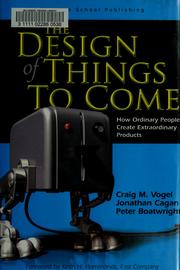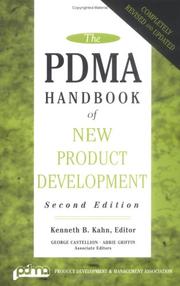| Listing 1 - 10 of 36 | << page >> |
Sort by
|

ISBN: 9780521826204 Year: 2005 Publisher: Cambridge Cambridge university press
Abstract | Keywords | Export | Availability | Bookmark
 Loading...
Loading...Choose an application
- Reference Manager
- EndNote
- RefWorks (Direct export to RefWorks)

ISBN: 0131860828 9780131860827 Year: 2005 Publisher: Upper Saddle River (N.J.): Wharton school,
Abstract | Keywords | Export | Availability | Bookmark
 Loading...
Loading...Choose an application
- Reference Manager
- EndNote
- RefWorks (Direct export to RefWorks)

ISBN: 046501433X Year: 2005 Publisher: New York Basic Books
Abstract | Keywords | Export | Availability | Bookmark
 Loading...
Loading...Choose an application
- Reference Manager
- EndNote
- RefWorks (Direct export to RefWorks)
New products --- New products --- Product management --- Management --- Marketing

ISBN: 0471485241 Year: 2005 Publisher: Hoboken, N.J. Wiley
Abstract | Keywords | Export | Availability | Bookmark
 Loading...
Loading...Choose an application
- Reference Manager
- EndNote
- RefWorks (Direct export to RefWorks)
In this Second Edition, experts in each area involved in new product development present the best practices for the industry. The very successful First Edition is now the body of knowledge for the Product Development and Management Association (PDMA) and is the single reference work that drives their professional certification exam.
New products --- Product management --- Management
Book
ISBN: 128022259X 9786610222599 0749445866 1598758268 Year: 2005 Publisher: Sterling, Va. : Kogan Page,
Abstract | Keywords | Export | Availability | Bookmark
 Loading...
Loading...Choose an application
- Reference Manager
- EndNote
- RefWorks (Direct export to RefWorks)
Designed to help innovators capture the full value of their creativity, this book combines the experience of innovative companies with the expertise of academics and advisors, bringing together current thinking and practice in innovation, strategy, marketing, design, intellectual property and finance.
Book
ISBN: 1281141399 9786611141394 3764376813 Year: 2005 Publisher: Basel ; Boston ; Berlin : Birkhäuser,
Abstract | Keywords | Export | Availability | Bookmark
 Loading...
Loading...Choose an application
- Reference Manager
- EndNote
- RefWorks (Direct export to RefWorks)
Design ist heute zu einem globalen Instrument geworden. Seine Entwicklung und Bedeutung wird anhand ausgewählter Länder Europas, Amerikas und Asiens vorgestellt. Mannigfaltige Unternehmensbeispiele machen das Buch zu einem aktuellen internationalen Kompendium des Designs. Der Autor zeigt die Entwicklung des Designs von seinen Anfängen im ausgehenden 19. Jahrhundert über die wichtigsten Bewegungen des 20. Jahrhunderts bis hin zur biologischen Wende, die das 21. Jahrhundert bestimmen wird. Die wichtigsten Grundlagen der Designtheorie und -methodologie werden vorgestellt, besonders auch die kommunikativen Funktionen der Produkte. Die aktuellen Erweiterungen hin zum Corporate- und Service Design, Design-Management und strategischem Design, Interface/Interaction-Design bis hin zum Human Design werden erläutert und anhand zahlreicher Beispiele anschaulich gemacht. Design today is a global instrument. Bernhard Bürdek traces the progress of design from its beginnings in the late 19th century, through the most significant movements of the 20th century up to those recent developments in biological engineering which will shape the 21st century. Design is now a discipline in its own right and its expertise can be incorporated within interdisciplinary processes. The most important fundamental principles of design theory and methodology are presented, looking in particular at the communicative function of products and highlighting aspects such as corporate and service design, design management, strategic design, interface/interaction design and human design.
Industrial design. --- Design. --- Design, Industrial --- Mechanical drawing --- New products --- Design

ISBN: 1281346500 9786611346508 0191518026 9780191518027 9780192842190 0192842196 9781281346506 6611346503 0192842196 Year: 2005 Publisher: Oxford ; New York : Oxford University Press,
Abstract | Keywords | Export | Availability | Bookmark
 Loading...
Loading...Choose an application
- Reference Manager
- EndNote
- RefWorks (Direct export to RefWorks)
From the Cadillac to the Apple Mac, the skyscraper to the Tiffany lampshade, the world in which we live has been profoundly influenced for over a century by the work of American designers. Meikle explores the fascinating history of American design, from the industrialization of the nineteenth century and the mass production of the machine age to the information-based society of the present, examining how design, consumerism, and culture connect. - ;From the Cadillac to the Apple Mac, the skyscraper to the Tiffany lampshade, the world in which we live has been profoundly influenced for over a c
Industrial design --- Design, Industrial --- Mechanical drawing --- New products --- Design --- History.
Book
Abstract | Keywords | Export | Availability | Bookmark
 Loading...
Loading...Choose an application
- Reference Manager
- EndNote
- RefWorks (Direct export to RefWorks)
"Fujita and Hill compare and contrast Tokyo's innovation structure with the industrial districts model and the international hub model in the literature on urban and regional development. The model embraces and yet transcends both industrial districts and international hub models. The authors provide key elements making up the Tokyo model--organizational knowledge creation, integral and co-location systems of corporate research and development and new product development, test markets, industrial districts and clusters, participative consumer culture, continuous learning from abroad, local government policies, the national system of innovation, and the historical genesis of Tokyo in Japan's political economy. They find that the Tokyo model of innovation will continue to evolve with the changing external environment, but fundamentally retain its main characteristics. The lessons from the Tokyo model is that openness, a diversified industrial base, the continuing development of new industries, and an emphasis on innovation all contribute to the dynamism of a major metropolitan region. This paper--a product of the Development Research Group--was prepared for the East Asia Prospect Study"--World Bank web site.
Industrial districts --- Knowledge management --- New products --- Technological innovations
Book
Abstract | Keywords | Export | Availability | Bookmark
 Loading...
Loading...Choose an application
- Reference Manager
- EndNote
- RefWorks (Direct export to RefWorks)
"Previous work has shown that firms in low and middle-income countries in Eastern Europe and Central Asia that feel greater pressure to innovate from their competitors are more likely to introduce new products and services than firms that do not feel pressure (Carlin and others 2001; World Bank 2004). However, competition also appears to affect innovation in other ways. In particular, firms in these countries that face greater price competition appear to be less likely to innovate than other firms (Carlin and others 2001). Clarke assesses how competition and trade policy affect these different aspects of competition and, consequently, assesses their net impact on innovation. He finds that reducing tariffs and enacting and enforcing competition laws modestly increases both the pressure that firms feel regarding innovation and the level of price competition in the domestic economy. The net impact that lower tariffs have on new product and process development appears to be negative but small--for the most part the opposing effects cancel out. In contrast, stricter competition laws and better enforcement of those laws appear to increase the likelihood of new product and process development, especially when competition is treated as endogenous to innovation. This paper--a product of the Growth and Investment Team, Development Research Group--is part of a larger effort in the group to understand the determinants of competition"--World Bank web site.
Competition --- New products. --- Technological innovations --- Government policy. --- Economic aspects.
Book
Abstract | Keywords | Export | Availability | Bookmark
 Loading...
Loading...Choose an application
- Reference Manager
- EndNote
- RefWorks (Direct export to RefWorks)
"Fujita and Hill compare and contrast Tokyo's innovation structure with the industrial districts model and the international hub model in the literature on urban and regional development. The model embraces and yet transcends both industrial districts and international hub models. The authors provide key elements making up the Tokyo model--organizational knowledge creation, integral and co-location systems of corporate research and development and new product development, test markets, industrial districts and clusters, participative consumer culture, continuous learning from abroad, local government policies, the national system of innovation, and the historical genesis of Tokyo in Japan's political economy. They find that the Tokyo model of innovation will continue to evolve with the changing external environment, but fundamentally retain its main characteristics. The lessons from the Tokyo model is that openness, a diversified industrial base, the continuing development of new industries, and an emphasis on innovation all contribute to the dynamism of a major metropolitan region. This paper--a product of the Development Research Group--was prepared for the East Asia Prospect Study"--World Bank web site.
Industrial districts --- Knowledge management --- New products --- Technological innovations
| Listing 1 - 10 of 36 | << page >> |
Sort by
|

 Search
Search Feedback
Feedback About
About Help
Help News
News